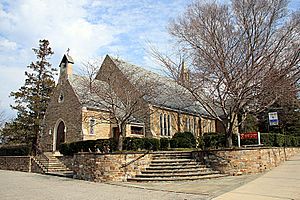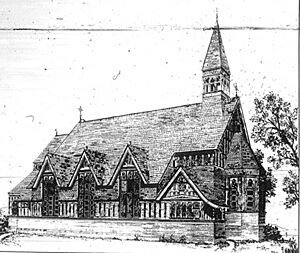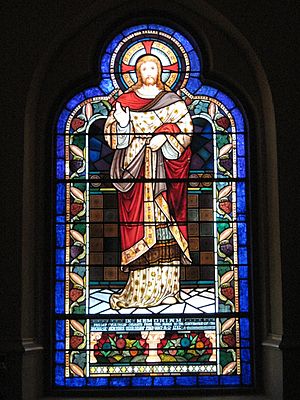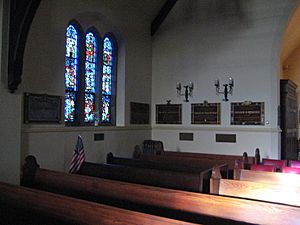Christ Church (Oyster Bay, New York) facts for kids
Quick facts for kids Christ Church |
|
|---|---|

Front elevation, 2008
|
|
| Religion | |
| Affiliation | ECUSA |
| Leadership | The Rev. Dr. Michael Piret, Rector |
| Location | |
| Location | 61 East Main Street Oyster Bay, New York 11771, United States |
| State | New York |
| Architecture | |
| Architectural type | Church |
| Architectural style | Carpenter Gothic |
| Specifications | |
| Direction of façade | West |
| Materials | Stone, slate |
| U.S. National Register of Historic Places | |
| Added to NRHP | 2018 |
| NRHP Reference no. | SG100003115 |
Christ Church is a very old and important Episcopal church in Oyster Bay, New York. It was started way back in 1705. This church has a long history, with several buildings standing on the same spot over the years. One of its buildings was even used by soldiers during the Revolutionary War!
The church building you see today was first built in the 1870s in a style called Carpenter Gothic. Later, in 1925, it was made much bigger and covered in stone. Beautiful stained glass windows were also added then. A famous American president, Theodore Roosevelt, attended this church. His wife and children were also active members. After President Roosevelt passed away in 1919, his funeral service was held right here. Today, Christ Church is a special stop on the Oyster Bay History Walk, which is an audio tour.
In 2018, Christ Church was added to the National Register of Historic Places. This means it's recognized as a very important historical site.
Contents
History of Christ Church Buildings
Christ Church has had several buildings on its site over the centuries. Each one played a part in the community's story.
- First Building (around 1707): This early building served as both a town hall and a church. It was a central spot for the community.
- Second Building (built 1750): This church was used by British and Hessian soldiers as barracks during the Revolutionary War. It was later taken down in 1801 because it was too damaged.
- Third Building (built 1844): After the war, it took a while for the church to recover. This building was constructed to serve the growing congregation.
- Current Building (built 1878, enlarged 1925): The main part of the current church was built in 1878. It was made of wood, and you can still see some of the original wooden beams inside. In 1925, it was greatly expanded and covered with stone. This is when the amazing stained glass windows were added.
Leaders of Christ Church
The church has been led by many rectors, which are like head pastors, since it began.
Early Rectors
The first rectors were sent by a group called the Society for the Propagation of the Gospel in Foreign Parts. They helped establish the church in Oyster Bay.
- John Thomas (1704–1724): He started his duties in Oyster Bay in 1705.
- Robert Jenney (1726–1742): He was a chaplain in the Royal Navy before becoming a rector.
- Samuel Seabury (1742–1764): He was a very important figure. His son, also named Samuel Seabury, became the first Episcopal bishop in America.
- Leonard Cutting (1766–1784): He taught at King's College (now Columbia University). He had to leave because he supported the British during the Revolution.
Rectors After the Revolution
After the American Revolution, the church went through a period of change.
- Andrew Fowler (1790)
- John Churchill Rudd (1805)
- Edward K. Fowler (1822–1826)
- Samuel Seabury (1826–1827)
- Joseph F. Phillips (1832–1835)
Rectors Since 1835
The church was reorganized in 1835 and has had many rectors since then.
- Isaac Sherwood (1835–1844)
- Edwin Harwood (1844–1846)
- John Stearns (1846–1849)
- Edmond Richards (1849–1851)
- Joseph Ransom (1852–1861)
- Richard Graham Hutton (1861–1874)
- Charles W. Ward (1874–1875)
- John Byron Murray (1875–1876)
- George Roe Van De Water (1876–1880)
- William Montague Geer (1880–1888)
- Henry Homer Washburn (1888–1911)
- George E. Talmage (1911–1934)
- Harold Pattison (1934–1940)
- John N. Warren (1940–1967)
- Robert Titus Hollett (1968–1987)
- Bruce D. Griffith (1987–2002)
- Peter F. Casparian (2004–2014)
- The Rev. Dr. Michael Piret (2015-Present): He is the current rector of Christ Church.
Christ Church's Long History
More than 300 years ago, the Church of England started holding services in Oyster Bay. Missionaries helped create Christ Church in 1705. This makes it one of the oldest churches on Long Island.
The first services were held in the "Town-House" in 1702. The land where the church stands today was once the town common. The town hall was located about where Christ Church is now. A new town hall was built in 1707 with space for church services. By 1750, a proper church building was put up. Eventually, the town gave the land and building to the church.
The American Revolution's Impact
The American Revolution changed things for the Church of England in America. Churches no longer received money from taxes. The church in Oyster Bay was damaged by soldiers who used it as a place to stay. It was in such bad shape that it had to be torn down in 1801. The rector, Leonard Cutting, supported the British and had to leave the area.
For about 50 years after the Revolution, the church in Oyster Bay struggled. Visiting clergy would sometimes hold services, but there wasn't a regular congregation.
Recovery and Growth
In 1802, the Oyster Bay Academy was started in a two-story building nearby. Students went to school there until a public school was built in the 1840s. After that, the old Academy building became the Christ Church rectory, which is where the rector lives.
The church congregation became active again in 1843. By 1844, they had built their third church building. This building was later moved to make way for the new church in 1878. Parts of the 1878 building are still visible today, like the wooden beams inside. The pews where the Theodore Roosevelt family sat are also still there. After President Roosevelt passed away, a simple funeral was held at Christ Church before he was buried nearby.
In 1925, the wooden 1878 building was covered in stone. This renovation also added the beautiful stained-glass windows, which were inspired by the famous Chartres Cathedral in France. In 1986, a wonderful pipe organ was installed. This organ, made by Hellmuth Wolff, helps with the church's music programs.
Inside the church, you can see plaques honoring many members of the Roosevelt family near their old pews. All around the church, there are other memorials for past members. Many of these names, like Underhill, Fleet, Townsend, and Youngs, are also names of places in the community.
The church has continued to be an active part of the community. In the 1980s, the old rectory was renovated, and the pipe organ was added. The church's interior was updated in the 1990s. More recently, in 2008, the Parish Hall was improved, along with the area around it.
See also
- List of Town of Oyster Bay Landmarks
- National Register of Historic Places listings in Oyster Bay (town), New York
External links
- Christ Church website




